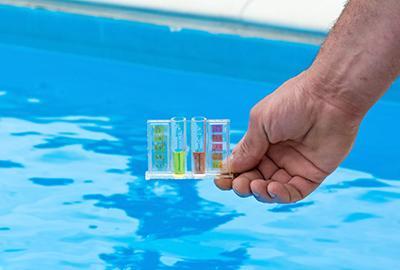The warmer months are nearly here, but let’s go back to school for a two-minute chemistry lesson, because maintaining a pool can get a little scientific. We’ve narrowed down pool chemistry to four key elements – get these right, and you’ll have a pool that’s clean, clear, and summer-ready.
pH
pH is the measurement of whether a substance is acidic (1-6), basic (8-14), or neutral (7).
From rain to dust; bird bombings to body lotions, anything and everything that enters your pool affects the pH level of the water.
A pool with a high pH prevents chlorine from working effectively and can cause calcium build-up, while a low-pH pool can cause the water to become acidic and corrosive – wreaking havoc on the hardware of your pool. This is why it’s crucial to maintain the right pH balance (which is ideally 7.4 to 7.6), as a neutral pH prevents red eyes and itchy skin.
Alkalinity
A pool’s alkalinity absorbs any radical changes in the water before they affect your pool’s pH level –so it acts as a buffer.
Since alkalinity safeguards pH, you should always focus on adjusting the alkalinity of your pool before adjusting your pH. Many times the pH will balance itself out as soon as the alkalinity is balanced.
Sanitiser
Your pool sanitiser keeps it free of bacteria, algae and viruses, and the most common type of pool sanitisers are chlorines.
Chlorine is an oxidizer which burns small organic matter from the inside out; for chlorine to do this properly, it needs to be within a balanced pH environment otherwise it will not be as effective.
Calcium
The amount of calcium in your pool determines how ‘hard’ or ‘soft’ your pool water is (but this will also depend largely on the area that you live in).
Like pH, you want to balance the calcium hardness in your pool, as calcium hardness is closely linked to pH. As mentioned, a high pH can lead to an increase in calcium, which will cause build-up on the sides and plumbing of your pool, and cause your pool water to be consistently cloudy.
Likewise a low pH – and therefore a pool with a calcium level that’s too low – will cause the water to become corrosive (and call for pricey repairs if it’s not balanced in time).
Confused? Do you need an expert from The Pool Team to help tutor you? Contact us; we’re here to help.

